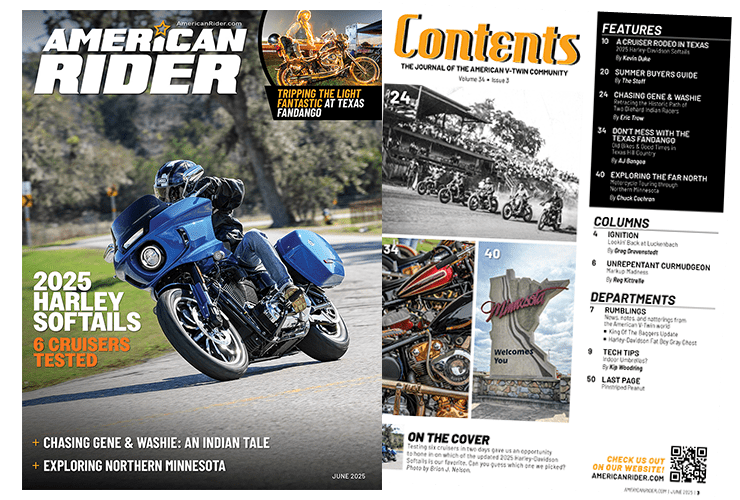Dialed in
Making adjustments for the ride
The XR1200X’s Showa-based suspenders offer plenty of options for setting the spring preload and damping rates to suit your riding style. Here’s a quick rundown of what you’ll be adjusting:
Spring rates for the front end—called Big Piston Fork (BPF)—are essentially the same as on last year’s XR1200 cartridge-style fork. But a small adjuster wheel at the base of each BPF fork leg allows you to change and set spring preload so you can control ride height and firmness. Using a 5mm hex key, rotate the adjuster in (clockwise) to increase preload, rotate out (counterclockwise) to decrease. The BPF’s large-diameter internal piston allows a reduction in damping pressure, which translates to better feedback and smoother action while riding the bike.
Fork damping adjustments are made at the top of each leg. Using a small flat-blade screwdriver, rotate the individual compression and rebound damping adjusters in or out to increase (clockwise creates a firmer ride) or decrease (counterclockwise generates a softer ride) damping. Each click of the adjuster signifies a new damping setting.
The nitrogen-charged rear shocks offer similar adjustability. The single-rate springs have five preload settings, and each XR1200X comes with a spanner wrench for rotating the adjustment cams. An access valve at the bottom of the remote reservoir allows for recharging the nitrogen if necessary.
You won’t need special tools to make the damping adjustments to the shocks, though. A small thumb wheel on the shock’s lower clevis lets you turn it with your fingers to set rebound damping. The “S” and “H” are there to remind you to rotate the screw either way for soft or hard damping.
You’ll find the compression damping adjuster at the top of the shock’s piggyback body. Again, “S” and “H” let you know which way to crank the small knob for desired rates. There’s little room to maneuver your man-size finger and thumb in the restrictive cavity, so reaching and turning the knob can be cumbersome. As up front, each click denotes changes to the rebound and compression rates.
Alan Barsi, Harley-Davidson’s technician assigned to prepare the bikes, set the suspension rates for 180-pound riders. We were invited to make changes to suit our individual weights and riding preferences. I weigh about 170 (dry; more after a few beers) and I eventually settled on the same damping rates prescribed by the factory. I left the fork preload setting alone as well. My only change was to increase rear spring preload from number four (second-softest preload) to number three (medium of the five settings). That minimized the rear tire sliding while exiting the chicane where the bike was at full lean during acceleration. Again, this was an extreme condition, and chances are slim to none that I’d experience this on the street.
For a cushy ride on the street you can dial back the damping settings a couple turns, or leave them as they are for the track. Either way you’ll enjoy the ride on this apex-chasing machine.




















Hi, I own a 2011 xr 1200x, you have adjustments for lets say a larger man, Im 260lbs, and would like to dial suspension in for the street, can you get me close,
I like to go up in the hills and ride, lots of twisties, just not sure if i have it dialed in as good as i can, can you send me some settings that would get me in the ballpark, much appreciated,,,thx, mike dejong